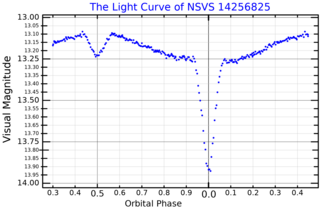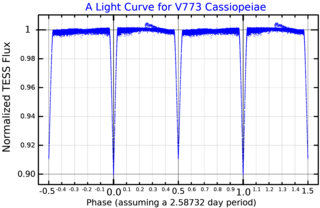
Eta Aquilae is the Bayer designation for a multiple star in the equatorial constellation of Aquila, the eagle. It was once part of the former constellation Antinous. On average, this star has an apparent visual magnitude of 3.87, making it one of the brighter members of Aquila. Based upon parallax measurements made during the Hipparcos mission, this star is located at a distance of roughly 1,382 light-years, although the parallax estimate has a 44% margin of error.
Rho Tucanae is a binary star system in the southern constellation of Tucana. It is visible to the naked eye with a combined apparent visual magnitude of +5.38. Based upon an annual parallax shift of 24.37 mas as seen from Earth, it is located 131 light years from the Sun.

Omicron Andromedae is a star system in the constellation Andromeda. It is approximately 692 light years from Earth. The system as a whole is classified as a blue-white B-type giant, with a mean combined apparent magnitude of +3.62.

Theta Aquilae is a binary star in the constellation Aquila. The combined apparent visual magnitude of the pair is 3.26, making it the fourth-brightest member of the constellation. In Chinese, it has the traditional name Tseen Foo, from the Chinese 天桴, which could mean "heavenly raft" or "heavenly ridgepole"; it might also mean "heavenly drumsticks", with Altair, Beta Aquilae and Gamma Aquilae being the drum. This distance to this star can be determined through the parallax technique, yielding an estimate of roughly 286 light-years from Earth.

Rho Aquilae, ρ Aquilae, is the Bayer designation for a star in the northern constellation of Delphinus. It has an apparent visual magnitude of 4.94 and is bright enough to be seen with the naked eye in good conditions.

Sigma Aquilae, Latinized from σ Aquilae, is the Bayer designation for a binary star system in the equatorial constellation of Aquila. The baseline apparent magnitude of the pair is +5.17, which, according to the Bortle Dark-Sky Scale, is bright enough to be seen with the naked eye from suburban skies. Because of the Earth's orbit about the Sun, this system has an annual parallax shift of 4.18 mas. This provides a distance estimate of approximately 780 light-years.

36 Aquilae is a star in the equatorial constellation of Aquila. 36 Aquilae is its Flamsteed designation though it also bears the Bayer designation e Aquilae. With an apparent visual magnitude of 5.02, this star is faintly visible to the naked eye. It has an annual parallax shift of 6.17 mas, indicating a physical distance of 530 light-years with a 30 light-year margin of error.

18 Aquilae is a triple star system in the constellation of Aquila. 18 Aquilae is the Flamsteed designation; it also bears the variable star designation Y Aquilae. It has an apparent visual magnitude of 5.07. The distance to this system can be estimated from the annual parallax shift of 6.43 mas, yielding a value of around 510 light-years away from Earth.
5 Aquilae is a quadruple star system in the constellation of Aquila. 5 Aquilae is the Flamsteed designation. The combined apparent visual magnitude of the system is 5.9, which means it is faintly visible to the naked eye. With an annual parallax shift of 8.94 mas, the distance to this system is estimated as approximately 360 light-years, albeit with a 13% margin of error.

44 Boötis or i Boötis is a triple star system in the constellation Boötes. It is approximately 41.6 light years from Earth.

π Lupi is a multiple star system in the southern constellation Lupus. Two components form a wide binary pair with an orbital period of 517 years and a semimajor axis of 1.59″. They belong to the Upper Centaurus Lupus component of the Sco–Cen complex.
4 Aquarii is a binary star system in the constellation Aquarius, located approximately 198 light years away from the Sun. 4 Aquarii is the Flamsteed designation. It is visible to the naked eye as a dim, yellow-white hued star with a combined apparent visual magnitude of 5.99. The system is moving closer to the Earth with a heliocentric radial velocity of −21.5 km/s.
HR 7955 is a binary star system in the northern circumpolar constellation of Cepheus, near the constellation border with Cygnus. It has a yellow-white hue and is faintly visible to the naked eye with a combined apparent visual magnitude of 4.51. The system is located at a distance of 89 light-years from the Sun, based on parallax. It has a relatively high proper motion, traversing the celestial sphere at the rate of 0.243 arc seconds per annum, and is drifting closer to the Sun with a radial velocity of -33 km/s.

NSVS 14256825, also known as V1828 Aquilae, is an eclipsing binary system in the constellation of Aquila. The system comprises a subdwarf OB star and red dwarf star. The two stars orbit each other every 2.648976 hours. Based on the stellar parallax of the system, observed by Gaia, the system is located approximately 2,700 light-years away.

ADS 1359 is a quadruple star system in the constellation Cassiopeia. It is composed of two sun like stars in an eclipsing binary with a 2.5-day period, which is in turn orbited by an A-type main-sequence star with a 185-year orbital period. There is also HD 236848 which is a distant proper motion companion.

KELT-3b is an extrasolar planet orbiting the F-type main-sequence star KELT-3 690 light years in the zodiac constellation Leo. It was discovered in 2013 by KELT's telescope in Arizona.

HS Hydrae is a triple star system in the equatorial constellation of Hydra. The inner pair were an eclipsing binary during the period 1920 until 2019, with HS Hya being the variable star designation. With a base apparent visual magnitude of 8.08, HS Hya is too dim to be viewed with the naked eye. During the primary eclipse, the magnitude dropped to 8.61; the secondary eclipse lowered the magnitude to 8.55. Based on parallax measurements, the system is located at a distance of approximately 335 light years from the Sun. It is drifting closer with a mean radial velocity of −7 km/s.










